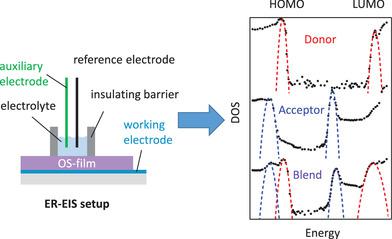当前位置:
X-MOL 学术
›
Adv. Funct. Mater.
›
论文详情
Our official English website, www.x-mol.net, welcomes your
feedback! (Note: you will need to create a separate account there.)
Mapping the Density of States Distribution of Organic Semiconductors by Employing Energy Resolved–Electrochemical Impedance Spectroscopy
Advanced Functional Materials ( IF 18.5 ) Pub Date : 2020-12-06 , DOI: 10.1002/adfm.202007738 Heinz Bässler 1 , Daniel Kroh 2 , Franz Schauer 3 , Vojtech Nádaždy 4, 5 , Anna Köhler 1, 2
Advanced Functional Materials ( IF 18.5 ) Pub Date : 2020-12-06 , DOI: 10.1002/adfm.202007738 Heinz Bässler 1 , Daniel Kroh 2 , Franz Schauer 3 , Vojtech Nádaždy 4, 5 , Anna Köhler 1, 2
Affiliation

|
Although the density of states (DOS) distribution of charge transporting states in an organic semiconductor is vital for device operation, its experimental assessment is not at all straightforward. In this work, the technique of energy resolved–electrochemical impedance spectroscopy (ER‐EIS) is employed to determine the DOS distributions of valence (highest occupied molecular orbital (HOMO)) as well as electron (lowest unoccupied molecular orbital (LUMO)) states in several organic semiconductors in the form of neat and blended films. In all cases, the core of the inferred DOS distributions are Gaussians that sometimes carry low energy tails. A comparison of the HOMO and LUMO DOS of P3HT inferred from ER‐EIS and photoemission (PE) or inverse PE (IPE) spectroscopy indicates that the PE/IPE spectra are by a factor of 2–3 broader than the ER‐EIS spectra, implying that they overestimate the width of the distributions. A comparison of neat films of MeLPPP and SF‐PDI2 or PC(61)BM with corresponding blends reveals an increased width of the DOS in the blends. The results demonstrate that this technique does not only allow mapping the DOS distributions over five orders of magnitude and over a wide energy window of 7 eV, but can also delineate changes that occur upon blending.
中文翻译:

利用能量分辨-电化学阻抗谱法绘制有机半导体的态分布密度
尽管有机半导体中电荷传输态的态密度(DOS)分布对于设备运行至关重要,但其实验评估却并非一帆风顺。在这项工作中,采用了能量分辨电化学阻抗谱(ER-EIS)技术来确定DOS价态(最高占据分子轨道(HOMO))和电子(最低未占据分子轨道(LUMO))状态的DOS分布。以纯净和混合膜的形式存在于几种有机半导体中。在所有情况下,推断的DOS分布的核心都是高斯分布,有时带有低能量尾巴。从ER-EIS和光发射(PE)或逆PE(IPE)光谱推断出的P3HT的HOMO和LUMO DOS的比较表明,PE / IPE光谱比ER-EIS光谱宽了2-3倍,暗示他们高估了分布的宽度。完整的MeLPPP和SF-PDI胶片比较2或具有相应混合物的PC(61)BM揭示了DOS在混合物中的宽度增加。结果表明,该技术不仅允许在五个数量级和7 eV的宽能量窗口上映射DOS分布,而且还可以描绘混合时发生的变化。
更新日期:2020-12-06
中文翻译:

利用能量分辨-电化学阻抗谱法绘制有机半导体的态分布密度
尽管有机半导体中电荷传输态的态密度(DOS)分布对于设备运行至关重要,但其实验评估却并非一帆风顺。在这项工作中,采用了能量分辨电化学阻抗谱(ER-EIS)技术来确定DOS价态(最高占据分子轨道(HOMO))和电子(最低未占据分子轨道(LUMO))状态的DOS分布。以纯净和混合膜的形式存在于几种有机半导体中。在所有情况下,推断的DOS分布的核心都是高斯分布,有时带有低能量尾巴。从ER-EIS和光发射(PE)或逆PE(IPE)光谱推断出的P3HT的HOMO和LUMO DOS的比较表明,PE / IPE光谱比ER-EIS光谱宽了2-3倍,暗示他们高估了分布的宽度。完整的MeLPPP和SF-PDI胶片比较2或具有相应混合物的PC(61)BM揭示了DOS在混合物中的宽度增加。结果表明,该技术不仅允许在五个数量级和7 eV的宽能量窗口上映射DOS分布,而且还可以描绘混合时发生的变化。































 京公网安备 11010802027423号
京公网安备 11010802027423号